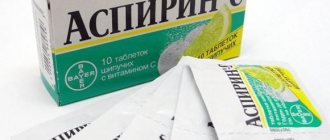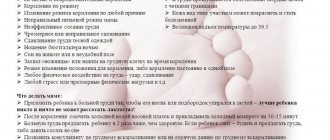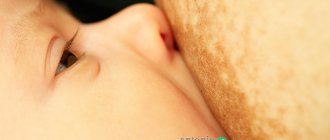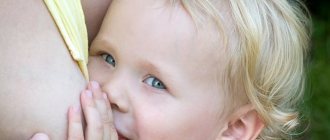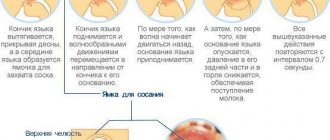Cold symptoms
When an adult becomes infected, the following signs appear:
- deterioration of general condition;
- headache;
- runny nose, swelling of the nose;
- weakness, body temperature above 38.5 degrees;
- possible cough.
The baby cannot tell what is hurting him, but the following symptoms will tell you that the baby is sick:
- anxiety, whims;
- sleep disturbance;
- thick discharge from the nasal cavity;
- high body temperature (up to 38 and above).
In the first months of life, a child is especially susceptible to colds; cases of illness and the need to treat colds in the summer are not uncommon. The immune system of an infant is not fully developed. A better prevention than breast milk has not yet been invented. It contains antibodies that kill various infections.
Danger of a cold
Influenza viruses travel quietly through the air from infected people to healthy people. It is not necessary to sneeze or cough; germs come out of the respiratory tract with air during normal conversation. The infection from the mother reaches the mucous membranes of the child's respiratory tract. If the mother is sick, there is no need to stop breastfeeding, since the antibodies produced by her immune system in response to infection enter the breast milk and protect the baby from infection.
If you do not attach much importance to a cold and do not treat it on time, you may encounter serious complications. It must be remembered that treatment of colds during breastfeeding cannot be done independently, since the vast majority of drugs that are familiar to us and used constantly are not suitable.
Is mother's cold dangerous while breastfeeding?
First you need to understand that ARVI is quite difficult to stop, because... The virus that has entered the body begins to be released from it even before the first symptoms appear. From this it becomes clear that isolation and even wearing a bandage when the first signs of the disease have already appeared will not change anything significantly. Yes, this will help prevent you from infecting those who have not had any contact with you before, but in relation to a child with whom you are constantly in close contact, this generally does not make much sense. However, it is prudent to follow basic hygiene recommendations when symptoms first appear: use disposable paper tissues and throw them away, wash your hands thoroughly, temporarily avoid face-to-face contact with your child, and try not to cough or sneeze on him.
We've sorted out the isolation. Why don’t we stop feeding then? Aren't viruses released in milk? In fact, there are very few viral diseases for which complete exclusion of hepatitis B is recommended (for example, human T-lymphotropic virus type 1 and human immunodeficiency virus) and classic autumn ARVIs are definitely outside this list of diseases. Indeed, at some point (in the so-called veramic phase), the virus enters the blood and, theoretically , may also end up in breast milk (BM). But, again, this happens even before the first symptoms and usually lasts for several hours. In parallel with this process, the mother’s body actively produces antibodies to the pathogen, and they also penetrate into the milk. Thus, an abrupt cessation of breastfeeding deprives the child of serious immune support , which the mother’s body was actively creating. Along with this, abruptly stopping breastfeeding and switching to formula is also an additional double blow for the child: the stress of weaning and the burden of the body with unusual, rather difficult to digest food. For the mother, temporarily stopping breastfeeding is fraught with unpleasant lumps in the chest , which in itself does not alleviate the condition. As a rule, babies who are on exclusive breastfeeding at the time of their mother’s illness either do not get sick at all or suffer a milder form of the disease.
Conclusion: a cold while breastfeeding is not a reason to stop breastfeeding.
Features of treatment for mother
Refusing to feed the child is indicated only in special conditions, when the disease is severe, against the background of a very high temperature, if the mother is prescribed a course of antibiotics or other potent drugs. Traditional methods of treating colds while breastfeeding are harmless and very gentle, but if they are adopted immediately, then most often the disease can be defeated without medications. Safe options include:
- warm vitamin tea with raspberries;
- thinly sliced lemon slices with honey;
- warmed milk with butter;
- mineral-enriched water (not carbonated);
- herbal collections with chamomile, linden blossom, calendula, mint.
Maintain bed rest, allow relatives to relieve you of household chores, and lie down as much as possible. You can steam your feet with mustard if you don't have a fever.
Why do breasts hurt when breastfeeding?
For some women, pain during breastfeeding is something to be expected, while others do not even think about the fact that something could go wrong. In any case, breast tenderness during lactation may indicate pathological processes. In this article we will look at the most common causes of chest pain during breastfeeding.
When is chest pain during breastfeeding physiological and does not require treatment?
Most often this happens at the very beginning of lactation, when the baby is just born. When milk replaces colostrum, the mother may experience a feeling of fullness in the chest, a dull pain, and the breasts may become dense and swollen.
A light massage from the nipple to the periphery and a cold compress will help relieve pain. It is also very important to properly attach the baby to the breast so that the emptying of the gland is most effective.
It hurts directly during breastfeeding. Nipples are sore and injured.
If it is painful for mom to feed, this may be due to nipple trauma. The most common reason for this is the child’s incorrect superficial grasp of the breast when sucking. A woman may experience pain both in the first moments of attachment and throughout the entire feeding. This pain is pathological and can lead to serious problems.
If the nipple is not deep enough in the baby's mouth, the gums squeeze it over and over again and rub it. Over time, abrasions, blisters appear, and then more serious problems - cracks.
Treatment with creams and nipple covers may provide partial relief or may not help at all. So it’s best to treat a sore nipple by correcting your baby’s latch.
Lactostasis and mastitis as a cause of pain during breastfeeding.
High temperature, swelling, redness of the sore breast, pain when pressed - all this
may be a consequence of both lactostasis and mastitis of the mammary gland. The symptoms of these diseases may be similar, but the treatment will be different.
With lactostasis there is inflammation, but no infection. Your doctor or lactation consultant can help you differentiate these problems from each other.
In the case of lactostasis, the best treatment will be frequent breastfeeding of a baby who sucks effectively and empties well, as well as massage and cold compresses.
With mastitis, a sick mother may also experience pain when breastfeeding, and the sooner she begins to treat this condition, the less likely she is to encounter such a formidable complication as an abscess. The doctor will prescribe treatment, and the sick woman will most likely be prescribed antibiotics. In the recent past, mastitis could have been a death sentence for lactation, but now this disease can be overcome effectively and without consequences for the baby and breast milk.
How to treat a cold
In such a difficult issue, drugs that supply the human body with interferons and agents that spur its own system to become more active against viruses can be useful. But even these medications are prescribed by a doctor. At high temperatures, you need to drink plenty of fluids - herbal teas or just warm water. Wear light clothing made from natural fabrics, apply cold compresses to the forehead, under the knees, and the bends of the elbows. Forget about wiping with water and vinegar, vodka, the skin will absorb everything like a sponge, this explosive mixture will end up in the milk.
Treatment of colds during pregnancy is similar to health procedures for breastfeeding. If there is no threat to the mother's life, it is better to refrain from drug options for relieving symptoms. Gargle with infusions of medicinal herbs, a solution of salt, soda and a drop of iodine.
Treatment of nursing mothers for infections
What to do and how to be treated if you do get sick? First of all, you need to see a doctor and understand what type of illness this is.
If the disease is viral in nature, then it is important to know that science has not developed drugs that improve the course of ARVI. It is necessary to give the body time to produce antibodies and make life easier for it in this difficult work. Bed rest, a cool, well-ventilated room with air humidity of at least 45-50%, plenty of drinking and sleep are important.
Antipyretic drugs can help alleviate the condition at high temperatures. Many of them are compatible with breastfeeding and do not pose a threat to the baby.
If it is a bacterial infection, including the common sore throat, cystitis, and sinusitis, antibiotics may be required (as is the case with infected mastitis, postpartum uterine inflammation, and postoperative complications). Fortunately, there are now many modern antibacterial drugs that are compatible with feeding.
Why you should take a closer look at Aqualor
A very effective and efficient drug of the new generation - Aqualor Soft. It is recommended for the prevention and complex treatment of influenza; it is allowed to be used from six months of age. For children from birth, you can use Aqualor baby in the form of drops or spray. During seasonal exacerbations of viral and respiratory diseases, take care of daily hygiene of the nasal cavity; you will save yourself from unwanted infections by washing viruses and bacteria from the mucous membrane.
The contents of the canister are sterile sea water, and it is known to be widely used in the treatment of all types of runny nose (allergies, colds), and prevents the entry of bacteria into the body and their reproduction.
Cold prevention
To avoid getting sick, perform nasal hygiene procedures every day, do not visit public places, wear clothes and shoes appropriate for the weather. Do not overcool your baby, the baby’s body is not yet strong, thermoregulation is just developing. Eat more fruits and vegetables, get the necessary vitamins. Stay outdoors in a park or garden, ventilate the room well, avoiding being in a draft. It is necessary to do wet cleaning. If the condition worsens, the temperature does not want to subside, sound the alarm and call a doctor. Do not prescribe aggressive medications yourself, which can have a detrimental effect on the child. The specialist will accurately determine the degree of the disease, prescribe gentle procedures and, if necessary, prescribe medications that will not harm a small child feeding on breast milk.
Instructions for mom during a cold
- Limit communication with the baby.
- Ventilate the nursery 2-3 times a day.
- If possible, install a bactericidal lamp in the nursery and turn it on in the absence of the baby for 10-15 minutes 2-3 times a day.
- Maintain bed rest.
- Provide plenty of warm drinks.
- Be sure to consult with a specialist, clarifying that you are a nursing mother.
- Read the instructions for the drug prescribed by your specialist again and make sure that it is compatible with breastfeeding.
